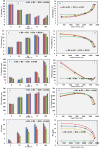Evaluation of the performance and gas emissions of a tractor diesel engine using blended fuel diesel and biodiesel to determine the best loading stages
- PMID: 33963237
- PMCID: PMC8105339
- DOI: 10.1038/s41598-021-89287-0
Evaluation of the performance and gas emissions of a tractor diesel engine using blended fuel diesel and biodiesel to determine the best loading stages
Abstract
Fossil fuels are the main energy sources responsible for harmful emissions and global warming. Using biodiesel made from waste deep-frying oil as an alternative fuel source in diesel engines has drawn great attention. This biodiesel is produced using the transesterification process and blends with mineral diesel at Faculty of Agriculture Saba Basha, Alexandria University, Egypt. The turbocharged diesel engine of a Kubota M-90 tractor was tested. The objectives of this work are to test tractor as a source of power in the farm using waste deep-frying oil biodiesel to utilize waste frying oils (WFO) in clean energy production on the farm and determine the best engine loading stages to maximize engine efficiencies for different fuel blends and reduce the environmental impact of gas emissions from tractor diesel engines in the farms. The experiment design was factorial, with two factors, where the first was the engine load (0%, 25%, 50%, 75%, and 100%) and the second was fuel blend (0%, 5%, 20%, and 100% biodiesel), and the effects of loading stages and biodiesel percentage on engine performance indicators of engine speed, power take off torque, power take off power, brake power, brake mean effective pressure, brake thermal efficiency, brake specific fuel consumption, and gas emissions were studied. The experimental results indicated that engine load percentage and fuel blend percentage significantly affected all studied characters, and the best engine loading stages were between 25 and 75% to maximize engine efficiency and minimize the specific fuel consumption and gas emissions. Increasing the biodiesel percentage at all loading stages resulted decreasing in Engine brake power (BP), brake thermal efficiency, Power take-off (PTO) torque, and brake mean effective pressure and increases in brake specific fuel consumption. Increasing the engine load resulted in decreases in O2 emissions and increases in CO2, CO, NO, and SO2 emissions. Increasing the biodiesel percentage in the blended fuel samples resulted in increases in O2 and NO emissions and decreases in CO2, CO, and SO2 emissions. The use of biodiesel with diesel fuel reduces the environmental impact of gas emissions and decreases engine efficiency.
Conflict of interest statement
The authors declare no competing interests.
Figures




Similar articles
-
Experimental investigation on performance and exhaust emissions of castor oil biodiesel from a diesel engine.Environ Technol. 2013 Jul-Aug;34(13-16):2019-26. doi: 10.1080/09593330.2013.777080. Environ Technol. 2013. PMID: 24350455
-
Diesel-Biodiesel-Water Fuel Nanoemulsions for Direct Injection and Indirect Injection Diesel Engines: Performance and Emission Characteristics.ACS Omega. 2022 Sep 21;7(39):34951-34965. doi: 10.1021/acsomega.2c03553. eCollection 2022 Oct 4. ACS Omega. 2022. PMID: 36211034 Free PMC article.
-
Effects of Diesel-Biodiesel-Ethanol-TiO2 Nanoparticle Blended Fuels on the Performance and Emissions of a Direct Injection Diesel Engine.ACS Omega. 2025 Apr 24;10(17):17337-17352. doi: 10.1021/acsomega.4c10500. eCollection 2025 May 6. ACS Omega. 2025. PMID: 40352481 Free PMC article.
-
Effect of nano-biodiesel blends on CI engine performance, emissions and combustion characteristics - Review.Heliyon. 2023 Oct 30;9(11):e21367. doi: 10.1016/j.heliyon.2023.e21367. eCollection 2023 Nov. Heliyon. 2023. PMID: 38027745 Free PMC article. Review.
-
Enhancing marine diesel engine compatibility with sustainable fuels: Key factors and adjustments.Mar Pollut Bull. 2025 Jun;215:117836. doi: 10.1016/j.marpolbul.2025.117836. Epub 2025 Mar 24. Mar Pollut Bull. 2025. PMID: 40132479 Review.
Cited by
-
Engine performance and emissions evaluation of surfactant-free B30 biodiesel-diesel/water emulsion as alternative fuel.Sci Rep. 2023 Jun 30;13(1):10599. doi: 10.1038/s41598-023-37662-4. Sci Rep. 2023. PMID: 37391435 Free PMC article.
-
Impact of Plant Spacing and Nitrogen Rates on Growth Characteristics and Yield Attributes of Egyptian Cotton (Gossypium barbadense L.).Front Plant Sci. 2022 May 12;13:916734. doi: 10.3389/fpls.2022.916734. eCollection 2022. Front Plant Sci. 2022. PMID: 35646020 Free PMC article.
-
Utilization of renewable biodiesel blends with different proportions for the improvements of performance and emission characteristics of a diesel engine.Heliyon. 2023 Sep 4;9(9):e19196. doi: 10.1016/j.heliyon.2023.e19196. eCollection 2023 Sep. Heliyon. 2023. PMID: 37809447 Free PMC article.
-
Modeling and prediction for diesel performance based on deep neural network combined with virtual sample.Sci Rep. 2021 Aug 18;11(1):16709. doi: 10.1038/s41598-021-96259-x. Sci Rep. 2021. PMID: 34408223 Free PMC article.
References
-
- Nabi MN, et al. Assessment of the use of a novel series of oxygenated fuels for a turbocharged diesel engine. J. Clean. Prod. 2019;217:549–558. doi: 10.1016/j.jclepro.2019.01.249. - DOI
-
- Marchetti J, Miguel V, Errazu A. Possible methods for biodiesel production. Renew. Sustain. Energy Rev. 2007;11:1300–1311. doi: 10.1016/j.rser.2005.08.006. - DOI
Publication types
LinkOut - more resources
Full Text Sources
Other Literature Sources

